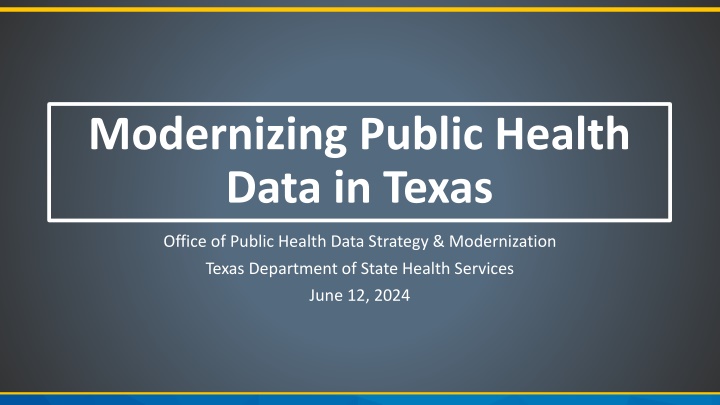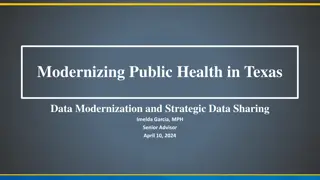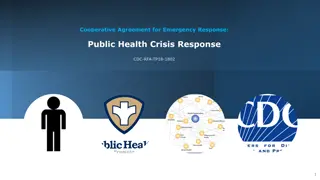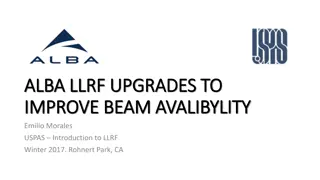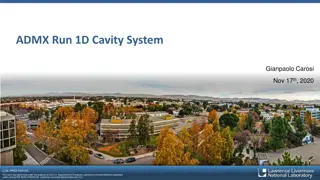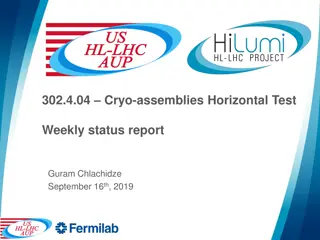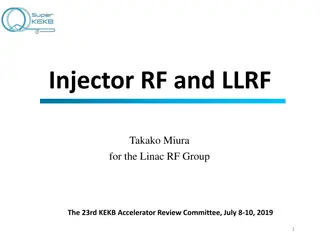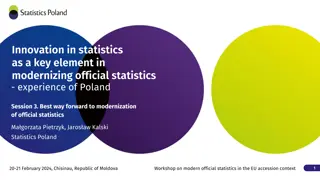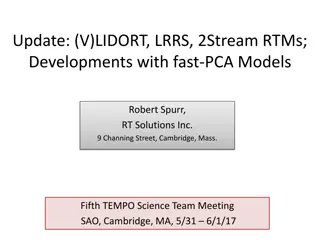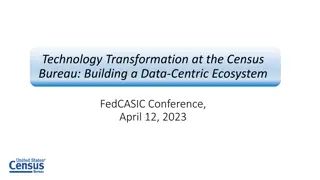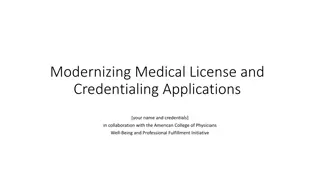Modernizing Public Health Data in Texas: Strategies and Upgrades
The Office of Public Health Data Strategy in Texas is undertaking modernization initiatives to enhance data visualization, sharing, and progress tracking. Upcoming upgrades include transitioning to NEDSS version 6.0.16, introducing new tools for data collection support, and improving reporting capabilities. Additional projects focus on electronic form submissions for early hearing detection, a maternal mortality review system, and enhancing child health quality improvement systems. Efforts aim to streamline workflows, improve data analytics, and support better health outcomes in Texas.
Download Presentation

Please find below an Image/Link to download the presentation.
The content on the website is provided AS IS for your information and personal use only. It may not be sold, licensed, or shared on other websites without obtaining consent from the author.If you encounter any issues during the download, it is possible that the publisher has removed the file from their server.
You are allowed to download the files provided on this website for personal or commercial use, subject to the condition that they are used lawfully. All files are the property of their respective owners.
The content on the website is provided AS IS for your information and personal use only. It may not be sold, licensed, or shared on other websites without obtaining consent from the author.
E N D
Presentation Transcript
Modernizing Public Health Data in Texas Office of Public Health Data Strategy & Modernization Texas Department of State Health Services June 12, 2024
Agenda Data Modernization Data Visualization Initiatives Data Sharing Progress 2
Upcoming NEDSS Upgrades Upgrading the system to version 6.0.16 and the addition of the FHIR Survey Administrator. Including Questionnaire Builder (QB) and Survey Administrator (SA) to provide data collection support in the initial stages of large-scale public health investigations. Modernized look Maintain current workflows Exploring options and feedback from epi staff NEDSS User Interface (UI) upgrade Facility Management Module Manage organizations via user interface Bulk Import of cases via NEDSS User Interface Users will be able to import new cases and update existing cases via UI using a CSV Page Builders for ALL conditions All conditions in NEDSS will be moved to a page builder and off legacy pages The U.S. Digital Service is set to add HIV/STD simple reports in the summer of 2024 Efforts to convert paper labs to electronic reporting for HIV/STD Improve e-faxing with the military Training Updating current NEDSS training and adding section for report generation. 4
Additional Modernization Projects Parent/Guardian Form for Texas Early Hearing Detection Electronic form submissions for Parents/Guardians for Texas Early Hearing Detection screening Maternal Mortality Review System (MMRS) The MMMRS will be a Texas-centric data system to support identification and MMMRC review of maternal death cases. The system will allow for more efficient and timely case identification, improved workflow tracking and case sharing efficiencies, support case review documentation and reporting, and streamline data analytics. Maternal Child Health Quality Improvement System (MCHQIS) Access to provisional hospital discharge data to support programs under Health and Safety Code, Chapter 34. Enhanced support of quality improvement (QI) measure reporting for TexasAIM and other MCH QI projects. Enhanced support and access to data visualizations for internal and external stakeholders such as Texas Legislature, DSHS Executive Leadership, Texas Collaborative for Healthy Mothers and Babies (TCHMB), Texas Medical Association (TMA), Texas Pediatric Society (TPS), Regional Advisory Councils/Perinatal Advisory Councils, and more. Decrease public health response times and improved health outcomes. Immunization s New Provider Activity Dashboard using PowerBI Reports Texas Immunization Provider Summary (TIPS) Provider Activity Report (PAR) Consent Acceptance Rate Evaluation (CARE) 5
MMRIA vs. MMRS The table below provides a summary comparison of features and enhancements for the Maternal Mortality Review System (MMRS) compared to the Maternal Mortality Review Information Application (MMRIA). Current State Future State M S FEATURE MMRS B a s e c a m p M M R I A O ffl i n e A c c e s s Case Based System: System organization is built around housing maternal mortality cases & case information from source records Document Storage: Location to house documents such as: Vital Events Spreadsheet & source records received per case Records Request Tracking: Tracking history log of all record request actions taken by DSHS MCH program team Case Narrative Development: Narrative forms per case available to compile one, complete case view with all source record information Role-level View (abstractor, analyst, committee member, etc.): Access levels in the system and per source record vary based on level assigned (i.e., committee members can not view identifiable information on a case or edit case information) Data Reports: Aggregate reports, overdose data reports, and data quality reports available to download, as well as a data dictionary Documentation of MMMRC Decision: Form for the MMMRC s decision on whether the death was pregnant related, if it could have been prevented, factors that contributed to the death, & recommendations to prevent future deaths Data Export Capabilities: Users can download data via CSV file Email and In-Application Notifications: Includes email and in-app notifications to alert MMRS users a case requires their attention Task Creation, Assignment, and Tracking : Ability to create tasks and track the status of a case from initial entry through completion Customized System Roles: Ability to create roles based on MCH program & case review needs Automated Data Redaction: Redactors will have the capability to use automated redaction technology on source record information Improved Data Analysis & Data Visualization Features: Integration with DSHS s SHARP (State Health Analytics Reporting Platform) for enhanced data dashboards and analytic capabilities. Data users will also be able to download data in specific charts and graphs. Future dashboards will include trends related to maternal and infant health and operational dashboards related to MMMRC case reviews. DSHS Agency-Owned and Operated: The system will be owned and managed by DSHS, including all user provisioning and access 6
MMRS Timeline TBD September 2023 March 2024 Enhancements Project Kickoff System Development System Implementation Requirements Gathering February 2025 October 2023 7
Data Visualization/Dashboards Timeline January 2024 July 2024 Late Summer/Early Fall NEDSS Respiratory Virus Congenital Syphilis (CS) Epi Profile ImmTrac2 Maternal and Child Health Maternal Health Additional Analysis TexasAIM Quality Improvement Analysis and Outcomes Congenital Syphilis Maternal and Child Health Infant Mortality and Morbidity Maternal Health Birth outcomes associated with CS June 2024 September 2024 9
MCH Dashboards Initial dashboards were created using the 2022-2023 Healthy Texas Mothers and Babies (HTMB) Databook Infant Mortality and Morbidity o Infant Mortality o Leading Causes of Infant Death o Preterm Birth o Low Birthweight Maternal Health o Maternal Mortality Ratio o Pregnancy Planning o Smoking o Maternal Mental Health o Pre-Pregnancy Weight Status o Hypertension/Diabetes o Drug Poisoning Go-Live date: June 18th 2024 10
Planned Data Sharing through SHARP THCIC Expansion Vital Event Expansion NEDSS Immtrac2 June-August 2024* ~30 new LHEs PUDF August-October 2024* ~30 new LHEs Frozen and provisional birth, death, fetal death, and birth infant death data Summer 2024* 68 LHEs Non-COVID conditions in NEDSS (including TB) June 2024* 50 LHEs Non-disaster, consented only data Training and support provided through webinars, office hours, SharePoint, and ad hoc requests. Additional data sets to be shared through SHARP are under discussion. 12 *Anticipated timelines based on current development progress.
Data Modernization NEDSS Success Stories Declared eICR readiness in October 2023. Have processed 180,844 transactions since declaration. Outbreak Management module implemented in December 2023. Integration between NEDSS and ImmTrac implemented in January 2024. TB transitioned from THISIS to NEDSS Smooth production implementation on February 20, 2024 61,724 labs processed in NEDSS since go-live 21,540 investigations automatically created Geocoding implemented for electronic lab reporting (ELR) and electronic case reporting (eCR) in April 2024. Improvements to Workflow Decision Support in April 2024 to provide more specificity and expand utility to a wider range of conditions. Multiple NEDSS software upgrades maintaining Texas on current CDC releases, currently 6.0.15.1. 13 13
TACCHO Data Workgroup Purpose: Provide a forum for collaboration on data with local health departments and DSHS. April 2024 Action Item: The workgroup will facilitate local health departments to share ideas and what is needed. Tentative Follow-up Meeting Date/Time: June 17, 2024, at 10:00 am Tentative Agenda Topic: Data sharing of infectious disease data via Snowflake and associated dashboards. 14
